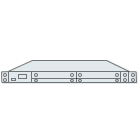Fiber Optic Tech
Optical Circuit Switch (OCS): Powering the Era of AI-Driven Compute Networks
As data centers scale rapidly and technologies like cloud computing, big data, and artificial intelligence (AI) advance, network switching technologies face unprecedented challenges. The traditional Optical-Electrical-Optical (OEO) switching architecture is increasingly showing limitations in bandwidth, latency, energy consumption, and cost. Optical Circuit Switch (OCS), an emerging all-optical switching technology, is becoming a critical component of data center network architectures. This article provides a detailed and systematic analysis of OCS’s industry background, market demand, bottlenecks of traditional OEO architectures, OCS’s application advantages, reasons for adoption, and market trends and challenges.
1. Industry Background
1.1 Evolution of Data Center Networks
The global data center market has experienced explosive growth in recent years. According to market research, the market size exceeded $300 billion in 2024 and is projected to grow at a compound annual growth rate (CAGR) of over 10% in the coming years. The rise of cloud services (e.g., AWS, Azure, Alibaba Cloud), AI training models (e.g., large language models), high-performance computing (HPC), and the proliferation of 5G and the Internet of Things (IoT) have placed unprecedented demands on data center networks for higher bandwidth, lower latency, and improved energy efficiency.
Traditional data center networks rely heavily on OEO switching, where optical signals are converted to electrical signals for processing and then converted back to optical signals for transmission. While this architecture has supported the internet’s growth for decades, its limitations are becoming evident in hyperscale data center environments.
1.2 Rise of OCS
Optical Circuit Switch (OCS) is an all-optical switching technology that routes signals directly in the optical domain, eliminating the need for optical-electrical conversion. Leveraging technologies like wavelength division multiplexing (WDM) and optical matrix switches, OCS enables high-bandwidth, low-latency, and energy-efficient signal transmission. Advances in microelectromechanical systems (MEMS), silicon photonics, and optical fiber technologies have reduced OCS costs, expanding its applications from traditional telecom networks to intra-data center and inter-data center interconnects.
2. Bottlenecks of Traditional OEO Architecture
The traditional OEO switching architecture faces several key limitations in modern data centers:
Bandwidth Constraints: OEO switches rely on electrical signal processing, which is limited by the processing speed and port density of electronic components. As data center traffic evolves from 10Gbps to 100Gbps, 400Gbps, and even 800Gbps, traditional electrical switches struggle to meet bandwidth and throughput demands.
High Energy Consumption: Optical-electrical conversion and electrical signal processing consume significant power. In hyperscale data centers, switches account for 30%-40% of total energy consumption. With growing global emphasis on green computing, high energy use is a major drawback of OEO architectures.
High Latency: OEO switching introduces additional latency due to optical-electrical conversion and electrical signal processing. In high-traffic scenarios, packet processing and queuing delays further degrade network performance.
Limited Scalability: The scalability of OEO switches is constrained by the port count and processing capacity of electrical switching chips. In hyperscale data centers, building multi-tier networks (e.g., Clos architectures) requires numerous switches, leading to complex cabling and high costs.
Cost Challenges: High-performance electrical switches are expensive to develop and manufacture, especially for 400Gbps and higher rates, where chip design complexity and cooling requirements drive up costs.
3. Application Advantages of OCS
Compared to traditional OEO architectures, OCS offers significant advantages:
High Bandwidth and Scalability: OCS supports ultra-high bandwidth transmission through all-optical switching, easily handling 100Gbps, 400Gbps, and beyond. Its high port density enables large-scale network topologies, making it ideal for hyperscale data centers and inter-data center interconnects.
Low Energy Consumption: By eliminating optical-electrical conversion, OCS consumes far less power than OEO switches. Studies suggest OCS can reduce energy consumption by 50%-70% compared to equivalent OEO switches, lowering data center operational costs.
Low Latency: OCS routes signals directly via optical switches, bypassing conversion and processing delays. This near-physical-limit low latency is critical for latency-sensitive applications like HPC and AI training.
Simplified Network Architecture: OCS supports flexible network topology configurations and dynamic optical path reconfiguration to adapt to varying traffic patterns (e.g., east-west or north-south traffic). This simplifies cabling and network management, reducing operational complexity.
Long-Term Cost Efficiency: Although OCS may have higher initial deployment costs, its low energy consumption, long lifespan, and minimal maintenance needs make it cost-effective over time.
4. Why Using OCS?
Meeting High-Bandwidth Demands: The explosive growth of AI training and inference tasks has driven a surge in east-west traffic (server-to-server) within data centers. OCS efficiently handles high-bandwidth, long-lived connections, making it ideal for GPU clusters and distributed storage systems.
Supporting Green Computing: Global focus on carbon neutrality is pushing data center operators toward low-power solutions. OCS’s energy efficiency aligns with the goals of green data centers.
Dynamic Network Optimization: OCS enables dynamic optical path reconfiguration based on real-time traffic demands, improving resource utilization in multi-tenant cloud environments.
Maturing Technology and Declining Costs: Advances in MEMS, silicon photonics, and optical fiber manufacturing have reduced OCS hardware costs, while hyperscale operators like Google, Microsoft, and Meta have validated its reliability through large-scale deployments.
Future-Proof Compatibility: OCS is highly compatible with technologies like WDM and coherent optical communication, ensuring seamless integration into next-generation optical network architectures and supporting future technologies like 6G and quantum communication.
5. Market Trends
Rapid Market Growth: According to market research, the global optical switching market (including OCS) is expected to grow at a CAGR of over 15% through 2030. Intra-data center and inter-data center interconnects are key growth drivers.
AI and HPC Driving Demand: AI training and inference tasks require large-scale GPU clusters and low-latency networks. OCS adoption is accelerating in these scenarios, with examples like Google’s TPU clusters and Meta’s AI infrastructure.
Expanding Telecom Applications: Beyond data centers, OCS is gaining traction in telecom networks. 5G and 6G networks require low-latency, high-bandwidth backbones, and OCS is well-suited for metro and long-haul networks.
Rise of Hybrid Switching Architectures: Future data center networks may adopt hybrid OEO-OCS architectures, where OEO switches handle short-lived, dynamic traffic, and OCS manages high-bandwidth, long-lived flows, optimizing performance and cost.
Standards and Ecosystems: Industry initiatives like the Compute Project are driving OCS hardware and protocol standardization, lowering adoption barriers and fostering market competition.
6. Market Challenges
Despite its advantages, OCS faces several challenges in market adoption:
High Initial Deployment Costs: OCS hardware, such as MEMS optical switches and fiber matrices, requires significant upfront investment, which may be prohibitive for smaller data centers.
Technical Complexity: OCS deployment requires specialized optical network design and debugging, increasing implementation complexity. Additionally, optical path reconfiguration software needs further optimization for reliability.
Compatibility with Existing Architectures: Most data centers rely on OEO-based networks, and integrating OCS may require redesigning network topologies, potentially causing compatibility issues during the transition.
Limited Adaptability for Dynamic Traffic: OCS excels at handling stable, long-lived traffic but is less efficient for short-lived, bursty traffic (e.g., web services) compared to OEO switches.
Supply Chain and Technology Maturity: While OCS technology is advancing, the supply chain for key components (e.g., high-density optical switches) remains unstable, potentially hindering large-scale deployment.
7. Conclusion
Optical Circuit Switch (OCS) is a transformative network switching technology reshaping data center and telecom network landscapes. Its high bandwidth, low energy consumption, low latency, and scalability make it an ideal solution for modern data center demands. Despite challenges like high initial costs and technical complexity, ongoing advancements in technology and cost reductions are driving broader adoption. As AI, HPC, and green computing continue to grow, OCS is poised to become a cornerstone of next-generation network architectures.
For enterprises considering OCS, partnering with specialized optical network providers and adopting hybrid switching architectures can balance performance and cost during the transition to all-optical networks. In the long term, OCS promises significant economic and environmental benefits, making it a strategic investment for future-proofing network infrastructure.



















